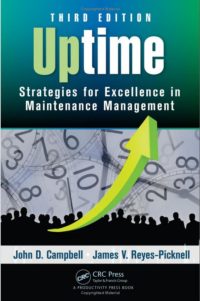Computerized data gathering and information management systems are indispensable tools for business. Just remember the last power failure you experienced and you’ll understand. Technology continues to develop and become more complex. The array of available business applications is astounding and more are added daily.
The world of maintenance, with all our work orders and valuable information that can help improve reliability performance, has seen multiple generations of management systems come and go. These systems can be a big help, or they can create huge distractions. Ultimately you want to make decisions informed by good data and verifiable information, you do not want to be distracted and side-tracked by the data.
Most maintenance work still requires some sort of human intervention. Artificial intelligence, machine learning, and robotics will be highly advanced when they can replace our tradespersons. Well into the foreseeable future, they will be gainfully employed. Considering that many younger people are still focused on technology, those trades will also be in-demand and well paid. They already are today!
The nature of maintenance is complex. Some of it is proactive and discretionary, some reactive and unavoidable. Complex plants and equipment have thousands of failure modes, each with the possibility of some proactive measure and repair activity. Some of those, often many, will also create damage in other items and generate the need for larger and more complex repairs. Failures may or may not be evident, and troubleshooting is often required to determine just what it is that needs to be repaired.
Technology is available to support condition monitoring, troubleshooting, data recording, work order issues and to facilitate access to technical manuals and parts lists. Some technology enables or supports the work while some helps us manage all the complexity.
Specialized support systems are used for data gathering, processing, analysis and decision making support. These tools are meant to help today’s knowledge workers, your maintenance technicians and engineers, do their jobs efficiently and more effectively. They are used to monitor equipment condition, analyze equipment performance trends, analyze failure history data, perform complex reliability calculations, provide support to equipment replacement decisions, forecast probabilities, etc. They are often designed as stand-alone systems to be used by trained specialists. Usually, they are tracking large data sets as we look for patterns. They are not transactional in nature, so they seldom integrate seamlessly with management information systems, that are.
These tools, in the right hands, can produce remarkable results and quickly earn a return on your investment.
Management information systems, on the other hand, are transactional. These include computerized maintenance management systems (CMMS), enterprise asset management (EAM) systems and enterprise resource planning (ERP) systems. They help by automating some steps in business processes (e.g.: automated purchasing when stock levels drop below pre-set levels, and automated issuance of work orders for scheduled maintenance). They automate business process information flows associated with a variety of business transactions (e.g.: sending a planned job for approval, then automatically sending it for scheduling when all parts are available).
The Work Order is the primary transaction tracking document. All the various transactions associated with getting work done and reported are tracked against that one document. You can get management reports, schedules and plans from which it is possible to see trends in performance measures and then to make management decisions. They support management processes. They can be expensive to acquire, install, implement and operate. They can take months or even years to get going, however, when coupled with business process re-design, the implementation of effective maintenance, inventory, and supply chain processes they can add a great deal of value. Done poorly, they can create barriers to work execution and lead to production delays.
They can be corporate enterprise systems deployed across multiple sites around the world, single-site installations, or software as a service deployed over the internet. The single purpose CMMS and purpose-built analytical systems tend to be easy to use. The more broadly deployed corporate systems, are broader in capability, highly integrated among various business functions (e.g.: maintenance, human resources, payroll, inventory, and purchasing), and more complex, being more difficult to use. The suppliers of these systems are working hard to change that.
One development is the emergence of standards for data interchange using internet architectures that would permit multiple systems, each having different purposes, to share data – one such standard is ISO 14224. This opens up the possibility for specialized decision support systems to gather needed data from management systems and vice versa.
The world of maintenance support and management systems is complex and crowded with competing products numbering in the hundreds. Choosing the right one for your purposes is not easy and shouldn’t be done without expert help. Don’t believe the salespersons either – they get nice commissions and many will tell you what you want to hear, just to make a sale.
Before you explore the options, decide on your business processes and the functionality the systems must support. Ask potential suppliers to demonstrate how their system meets your needs. DO NOT believe promises of functionality that they cannot demonstrate live. As a buyer, you need to be wary of promises and claims. We offer technology consulting services to help you find your way through the jungle.
As a rule, I live by a motto that “if you believe it, you will see it”. When it comes to software, it’s the other way around. If I don’t see it, I don’t believe it.
Uptime Training Courses Now Available:
We begin our Uptime improvement programs with education. This helps you make informed choices about what to do or not to do, based on your existing knowledge of your current practices when compared with proven successful practices.


